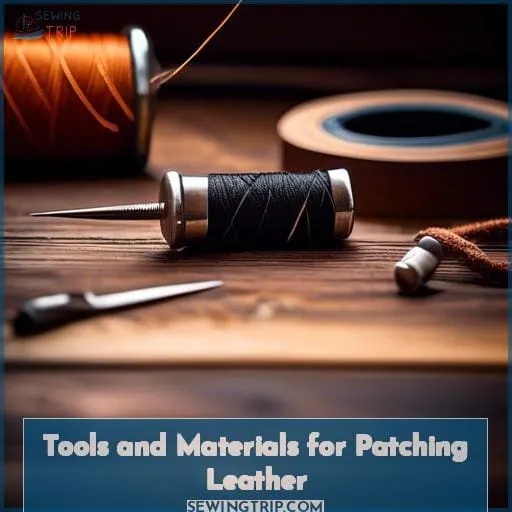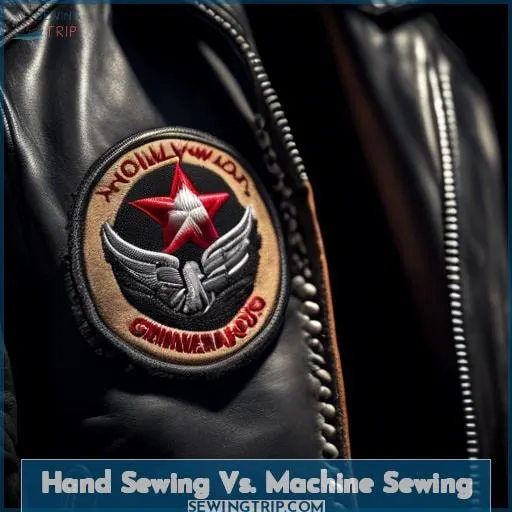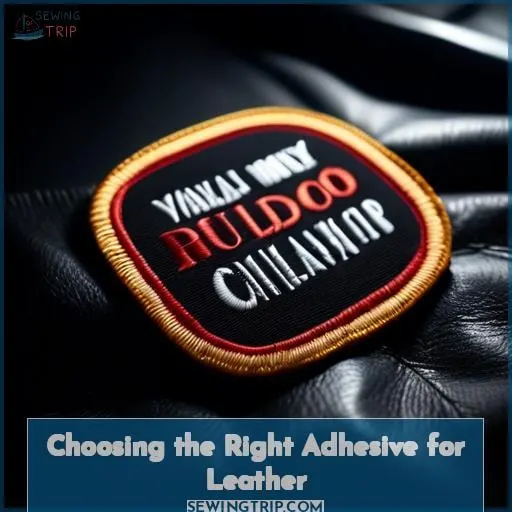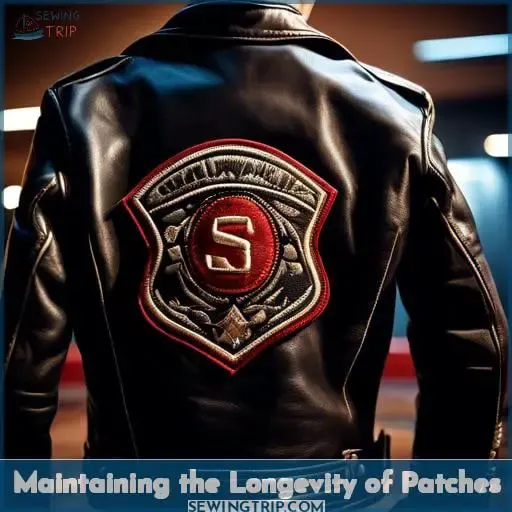This site is supported by our readers. We may earn a commission, at no cost to you, if you purchase through links.
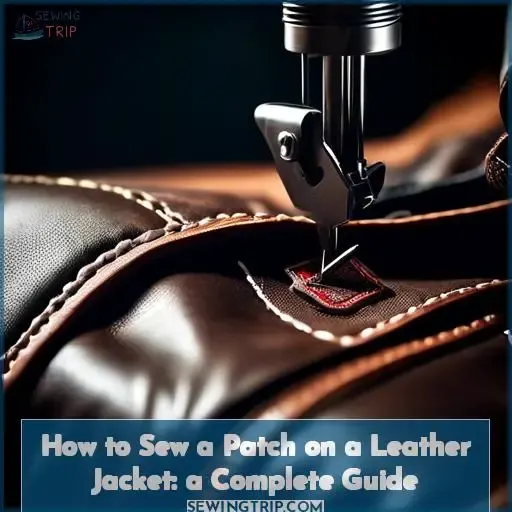 Ever wondered how to seamlessly sew a patch on a leather jacket, elevating its style and personalizing it to your taste? This comprehensive guide will walk you through the tools and techniques needed, whether you’re hand stitching or using a machine.
Ever wondered how to seamlessly sew a patch on a leather jacket, elevating its style and personalizing it to your taste? This comprehensive guide will walk you through the tools and techniques needed, whether you’re hand stitching or using a machine.
We’ll also delve into the best adhesives for a durable hold, share expert tips for perfect placement, and advise on maintaining your patches.
Get ready to master the art of leather patching and take control of your fashion statement.
Table Of Contents
Key Takeaways
- Use a sturdy leather needle and resilient nylon or polyester thread to ensure the durability of the patch attachment.
- Consider the placement of the patch carefully, avoiding areas of high flex to maintain the integrity of both the patch and the jacket.
- Employ leather-friendly adhesives, such as fabric glue or spray adhesive, for additional hold and to facilitate easier sewing.
- Regular maintenance, including leather conditioning and UV protection, is crucial to preserve both the patch and the jacket over time.
Tools and Materials for Patching Leather
Ready to make your leather jacket a badge of your personality? Let’s gear up!
First, grab a sturdy leather needle and some resilient nylon or polyester thread that won’t wimp out on you. Your patch placement is key—like a general positioning his troops, you want it just right.
Now, for the sticky situation: adhesive selection. Choose a leather-friendly glue that won’t quit on you but doesn’t gas you out with VOCs.
When it comes to sewing techniques, think like a surgeon—precise and clean. Ensure your materials are chummy with each other to avoid a durability debacle.
Now, let’s get that patch on your leather jacket and show ’em who’s boss!
Hand Sewing Vs. Machine Sewing
When you’re ready to add that personal touch to your leather jacket with a patch, you’re faced with a choice: hand sewing or machine sewing.
Each has its charm and challenges. Hand sewing lets you control every stitch, ensuring your needle dives just deep enough without piercing through the entire jacket. It’s like being a surgeon, but for leather. You’ll need a sturdy needle and thread that can stand up to the toughness of leather.
Machine sewing, on the other hand, is like riding a bike with no hands—thrilling but requires skill.
Whether you choose the meticulous care of hand sewing or the speed of machine sewing, remember, the right needle selection and thread type are your best pals in this journey.
Choosing the Right Adhesive for Leather
When selecting an adhesive for your leather jacket patches, it’s crucial to consider durability and the potential for volatile organic compound (VOC) emissions.
You’ll also want an option that allows for some repositioning flexibility to get the placement just right.
Adhesive Durability
After mastering the stitch, it’s time to pick your glue wisely. Here’s a quick rundown:
- Adhesive Strength: Contact cement and fabric glue ensure your patch won’t budge.
- Peel Resistance: Spray adhesive and patch glue laugh in the face of wear and tear.
- Heat and Water Resistance: Carpet tape holds strong, come rain or shine, making it a trusty sidekick in your patching adventures.
VOC Emissions
When choosing an adhesive for your leather jacket patch, dodge VOC hazards like a pro. Adhesive toxicity isn’t just a buzzkill for your health; it’s a nemesis for the environment too.
Opt for low-VOC options or polyurethane construction adhesive to keep the air as fresh as your style. Remember, a well-ventilated workspace is your best ally—no ifs, ands, or buts.
Repositioning Flexibility
When you’re ready to stick that patch onto your leather jacket, consider these key points:
- Adhesive Strength: You want a glue that holds tight but doesn’t turn your patch application into a wrestling match.
- Cost and Smell: Don’t break the bank or your nose—opt for an adhesive that’s affordable and low on the solvent stink-o-meter.
- Resistance Factors: Look for heat and UV resistance to keep those biker patches looking sharp on the open road.
Tips for Applying Patches to Leather
Applying patches to your leather jacket isn’t just about making a statement; it’s about mastering the art of personalization.
- Patch Placement: Think of your jacket as a canvas. Place patches where they tell your story best, but avoid areas that flex a lot to prevent peeling.
- Needle Selection: A sharp, sturdy needle is your best friend. Leather demands respect, and a dull needle just won’t cut it.
- Thread Choice: Opt for nylon or polyester. These threads are like the secret sauce that keeps everything together, without stealing the spotlight.
- Stitch Pattern: Keep it simple but secure. A straight stitch does the trick, blending in while holding firm.
- Adhesive Alternatives: Sometimes, you need a little extra hold. Fabric glue or double-sided tape can be your backstage crew, ensuring the patch sticks around for the encore.
Maintaining the Longevity of Patches
To ensure your leather jacket’s patchwork stands the test of time, you’ve got to play the long game. Think of it as a relationship between materials that needs constant nurturing. Regular leather care is your love letter to durability, while choosing the right adhesive is like a strong handshake between the patch and the jacket.
Sewing is the thread that binds this union, and UV resistance is the sunscreen that keeps your patch from fading like a summer romance.
| Care Action | Why It Matters | Emotional Payoff |
|---|---|---|
| Regular Conditioning | Prevents leather from drying out | Your jacket stays supple and strong, like a trusty steed |
| UV Protection | Shields patch from sun damage | Keeps colors vibrant, like memories that never fade |
| Right Adhesive | Ensures solid bond without damage | Your patch stays put, as reliable as an old friend |
Frequently Asked Questions (FAQs)
Can patches be removed without damage?
Yes, you can peel off patches without wrecking your leather jacket. It’s like removing a band-aid gently.
It’s a delicate dance, but doable!
Are embroidered patches more durable?
Embroidered patches boast a rugged charm, outlasting their woven counterparts with their thick, hearty threads.
They’re like the denim of the patch world—getting better with age and wear, perfect for your leather jacket’s adventurous spirit.
How to clean jackets with patches?
Dive into jacket care like a pro: gently wipe with a damp cloth and mild soap, avoiding soaking.
For tough spots, a soft brush and soapy water are your secret weapons.
Keep it snappy and effective!
Do patches affect leather’s breathability?
Yes, patches can impact leather’s breathability. By covering the pores, they restrict air and moisture flow, making your jacket less airy.
It’s like putting a raincoat on your skin—effective but less breathable.
Are there vegan alternatives to leather patches?
Imagine jazzing up your jacket with a patch that’s kind to cows.
Vegan leather patches, like those made from jacron or Piñatex, offer a cruelty-free swagger without skimping on style.
Conclusion
Just like a skilled artist transforms a blank canvas into a masterpiece, you’ve learned to masterfully sew a patch on a leather jacket, making it uniquely yours.
Armed with the right tools, knowledge of hand versus machine sewing, the best adhesives, and maintenance tips, you’re set to elevate your style.

